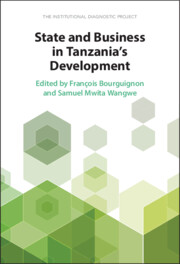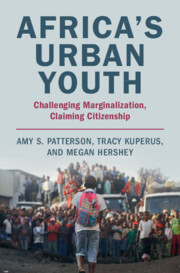339 results
Dietary diversity moderates household economic inequalities in the double burden of malnutrition in Tanzania
-
- Journal:
- Public Health Nutrition / Accepted manuscript
- Published online by Cambridge University Press:
- 16 May 2024, pp. 1-24
-
- Article
-
- You have access
- Open access
- Export citation
6 - Territorial Oppositions in African Politics
-
- Book:
- Inequality and Political Cleavage in Africa
- Published online:
- 18 April 2024
- Print publication:
- 25 April 2024, pp 168-194
-
- Chapter
- Export citation
Economic Burden of Livestock Abortions in Northern Tanzania
-
- Journal:
- Journal of Agricultural and Applied Economics , FirstView
- Published online by Cambridge University Press:
- 16 February 2024, pp. 1-21
-
- Article
-
- You have access
- Open access
- HTML
- Export citation
8 - Four Neighbours, Four Regimes
-
- Book:
- Theorizing in Comparative Politics
- Published online:
- 04 January 2024
- Print publication:
- 18 January 2024, pp 116-133
-
- Chapter
- Export citation
The Nature of Zeolite Occurrences in Deposits of the Olduvai Basin, Northern Tanzania
-
- Journal:
- Clays and Clay Minerals / Volume 53 / Issue 6 / December 2005
- Published online by Cambridge University Press:
- 01 January 2024, pp. 659-673
-
- Article
- Export citation
13 - An Overview of Urban Planning in Tanzania
- from Part II - Case Studies on Urban Planning in African Countries
-
-
- Book:
- Reimagining Urban Planning in Africa
- Published online:
- 07 December 2023
- Print publication:
- 21 December 2023, pp 216-236
-
- Chapter
- Export citation
Cheetahs in Tanzania's Selous–Nyerere ecosystem: lack of evidence for current persistence, and reflections on historical status
-
- Journal:
- Oryx , First View
- Published online by Cambridge University Press:
- 15 December 2023, pp. 1-5
-
- Article
-
- You have access
- Open access
- HTML
- Export citation
Global Forces, Rural Radicalism, and the Dual Transformation of Urban and Rural Protest in Africa
-
- Journal:
- African Studies Review , First View
- Published online by Cambridge University Press:
- 07 December 2023, pp. 1-22
-
- Article
- Export citation
Contested Truths Over COVID-19 in East Africa: Examining Opposition to Public Health Measures in Tanzania and Uganda
-
- Journal:
- African Studies Review / Volume 66 / Issue 4 / December 2023
- Published online by Cambridge University Press:
- 22 November 2023, pp. 873-898
-
- Article
-
- You have access
- Open access
- HTML
- Export citation

State and Business in Tanzania's Development
- The Institutional Diagnostic Project
-
- Published online:
- 09 November 2023
- Print publication:
- 23 November 2023
-
- Book
-
- You have access
- Open access
- Export citation
3 - Uncertain Development Trajectories in Bangladesh and Tanzania
- from Part II - Lessons from Country Case Studies
-
- Book:
- Institutional Challenges at the Early Stages of Development
- Published online:
- 09 November 2023
- Print publication:
- 09 November 2023, pp 89-125
-
- Chapter
-
- You have access
- Open access
- HTML
- Export citation
Validation of a culturally sensitive, Swahili-translated instrument to assess suicide risk among adults living with HIV in Tanzania
-
- Journal:
- Cambridge Prisms: Global Mental Health / Volume 10 / 2023
- Published online by Cambridge University Press:
- 05 October 2023, e67
-
- Article
-
- You have access
- Open access
- HTML
- Export citation
Agency and the Arusha Declaration: Nyerere, NUTA, and Political Discourse in Tanzania, 1966–7
-
- Journal:
- The Journal of African History / Volume 64 / Issue 3 / November 2023
- Published online by Cambridge University Press:
- 29 September 2023, pp. 368-387
- Print publication:
- November 2023
-
- Article
-
- You have access
- Open access
- HTML
- Export citation
Farmers’ heterogeneous preferences for traits of improved varieties: Informing demand-oriented crop breeding in Tanzania
-
- Journal:
- Experimental Agriculture / Volume 59 / 2023
- Published online by Cambridge University Press:
- 13 September 2023, e19
-
- Article
- Export citation
9 - African Nationalism, Anti-Imperial Lexicons, and the Development of China–Tanzania Relations, 1960–1966
- from Part II - Solidarities and Their Discontents
-
-
- Book:
- The Anticolonial Transnational
- Published online:
- 10 August 2023
- Print publication:
- 24 August 2023, pp 177-196
-
- Chapter
- Export citation
Health needs assessment for the double burden of malnutrition: a community-based study on nutrition facilitators and barriers in rural Tanzania
-
- Journal:
- Public Health Nutrition / Volume 26 / Issue 11 / November 2023
- Published online by Cambridge University Press:
- 15 August 2023, pp. 2450-2459
-
- Article
-
- You have access
- Open access
- HTML
- Export citation
1 - Theorizing Urban Youth and Everyday Citizenship
-
- Book:
- Africa's Urban Youth
- Published online:
- 10 August 2023
- Print publication:
- 10 August 2023, pp 13-45
-
- Chapter
- Export citation
7 - Channeling Frustration through Exit, Exclusion, and Engagement
-
- Book:
- Africa's Urban Youth
- Published online:
- 10 August 2023
- Print publication:
- 10 August 2023, pp 173-198
-
- Chapter
- Export citation
5 - Contesting Citizenship through Religious Identity
-
- Book:
- Africa's Urban Youth
- Published online:
- 10 August 2023
- Print publication:
- 10 August 2023, pp 118-144
-
- Chapter
- Export citation

Africa's Urban Youth
- Challenging Marginalization, Claiming Citizenship
-
- Published online:
- 10 August 2023
- Print publication:
- 10 August 2023



